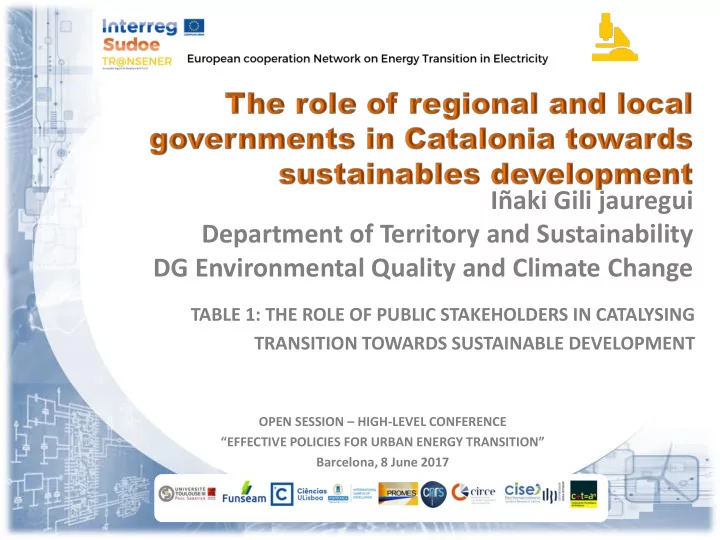

Iñaki Gili jauregui Department of Territory and Sustainability DG Environmental Quality and Climate Change TABLE 1: THE ROLE OF PUBLIC STAKEHOLDERS IN CATALYSING TRANSITION TOWARDS SUSTAINABLE DEVELOPMENT OPEN SESSION – HIGH-LEVEL CONFERENCE “EFFECTIVE POLICIES FOR URBAN ENERGY TRANSITION” Barcelona, 8 June 2017
Multilevel relationship Problems One of the very encouraging effects of the international climate change negotiations is that we are seeing ever increasing actions on both undertaken at the national, adaptation and mitigation subnational and local levels . We have learned over the past few top down years that the path forward cannot be either a (intergovernmental regulation) or a bottom up exercise (domestic policies, business action, public engagement). The path forward has to be the result of concurrent, mutually reinforcing efforts that help us to spiral up toward the tipping point of transformation. Climate Change: Why We Need a Multilateral Solution S. Rajaratnam School of International Studies. Singapore, 18 October 2012 Christiana Figueres, Executive Secretary United Nations Framework Convention on Climate Change 2
Catalan context Different levels of governance The objectives of the EU (and UNFCCC) for the non ETS sectors are binding only on the level of countries The relationships between the federal Objectives Responsibilities Resources and the regional government are of great importance. At regional level Countries are built in different organizational levels, and a large part of the responsibilities on climate policy, specially in non ETS sectors, are in the hands of regional and local governments. 3
4
5
Multilevel relationship Problems Federal Administration Spanish objective 2020 Regional Administration Competences / jurisdiction Local Administration • Decoupling between the reduction targets established at the Spanish level and the other levels of government. • Difficulties to include the regional or local action in the state sectorial plans. • If the goals do not come down to territorial scale, an autonomous region or a municipality has no obligation to reduction (mitigation) or to act (adaptation). Neither a legally binding obligation, nor a reference to what should be done. 6
Roadmap towards a low-carbon society in Catalonia Main Catalan Actions • 2005 1st report on Climate Change in Catalonia • 2006 Catalan Office for Climate Change • Climate Change Convention: 1.000 proposals; 800 participants • KP Mitigation Framework Plan 2008-2012 (voluntarily 2008 commitment) • Monitoring & Evaluation: annually since 2009 • 2009 Carbon Expo / BCN talks (UNFCCC) • 2nd report on Climate Change in Catalonia 2010 • Voluntary Agreement Program (160 organizations joined) • Carbon Expo 2011 • Kick off Climate Change Observatory of Pyrenees • Energy & Climate Plan 2020 2012 • Catalan Strategy for adapting to climate change 2013- 2020
Roadmap towards a low-carbon society in Catalonia Main Catalan Actions • Carbon Expo • 2013 Climate Change Act: Kick off • Life project on Adaptation MEDACC: forest, agriculture and water (5 y) • Climate Change Act: proposal approved by Government • “INDC” (2030 targets) COP21 Paris • 2015 Adaptation indicators • Launch: CO2eq Offsetting program • Life project on Adaptation ADMICLIM: tourism, agriculture, water, fisheries (4 y) • First tender CO2eq Offsetting program • Climate Change Act: discussion in the Parliament • ForEsmap: Evaluation and mapping of ecosystem services of forests • 2016 Evaluation & Monitoring Catalan Strategy for adapting to climate change • Life project on Adaptation CLINOMICS: tourism, agriculture, forest (5 y) • Study of vulnerability and building capacity for local Adaptation Plans • 3rd report on Climate Change in Catalonia • Life project on mitigation CLIMARKT: Markets and forest management (4 y) • 2017 Roadmap 2020 • Innovate for Climate 8
Roadmap towards a low-carbon society in Catalonia Climate Change Act The different programmes that have been described before, are actions that the Government of Catalonia has decided to develop in order to fulfil its commitment towards the Catalan society and also towards the objectives set up in the EU, as a developed region. But the Government of Catalonia has decided to go further and it is engaged in the elaboration of a Climate Change Act. This initiative will boost a political and social debate in the Catalan society that ultimately will make the Catalan climate action stronger to face future challenges 9
Roadmap towards a low-carbon society in Catalonia Climate Change Act 1 2 CLIMATE CHANGE & SECTORIAL POLICY 4 3 10
Current situation (2015) GHG emissions 31.200 MT CO 2 (WEO2012). 50.000 MT CO 2eq (IPPC/AR5 -2010) <0,1% 335,7 MT CO 2 eq. 13% 1% 43,5 MT CO 2 eq. 4.306,7 MT CO 2 eq. 11
Current situation (2015) GHG emissions 2015: +0,8% vs 2014 +12% vs 1990 12
Targets Horizon 2020 and 2030 2030 2020 Govern agreement 20.10.2015 EFICIENCY & RENEWALS 40% 25% 20% INCREASE REDUCTION REDUCTION GHG vs 2005 GHG vs 2005 Target ETS emissions reduction 39% vs 2005 51% vs 2005 Target non ETS emissions reduction 15% vs 2005 28% vs 2005 13
Thank you very much !! Iñaki Gili Jauregui Direcció General de Qualitat Ambiental i Canvi Climàtic Av. Diagonal, 523-525 08029, Barcelona http://territori.gencat.cat/ca/inici/ http://canviclimatic.gencat.cat/ca/
Recommend
More recommend